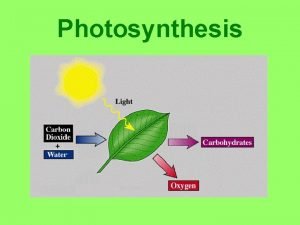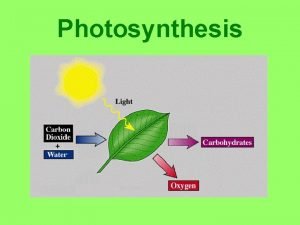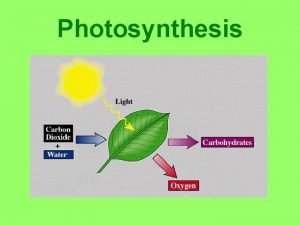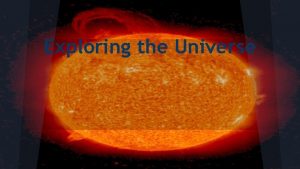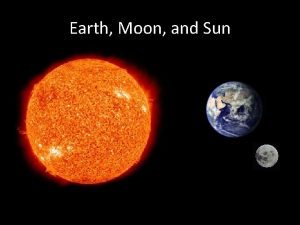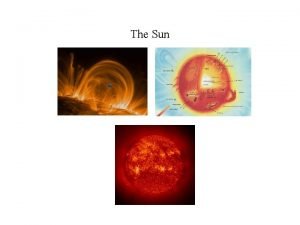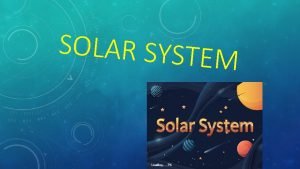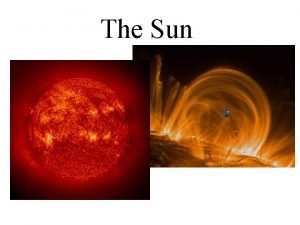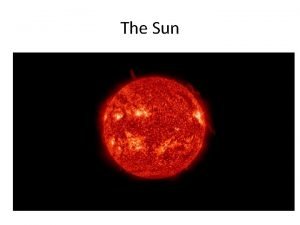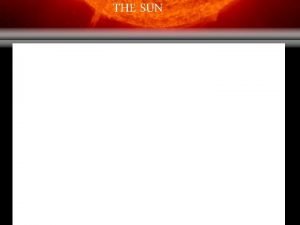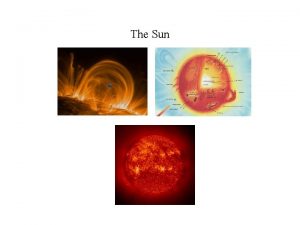26 1 The Sun The sun gives off





















- Slides: 21

26. 1 The Sun The sun gives off tremendous amounts of energy. Plants on Earth use sunlight directly in photosynthesis.

26. 1 The Sun Energy From the Sun How does the sun produce energy? The sun’s energy is produced in its central region by the fusion of hydrogen nuclei into helium nuclei.

26. 1 The Sun Energy From the Sun Nuclear fusion within the sun’s central region converts mass into energy. The green particles in the diagram are protons, and the purple particles are neutrons. Hydrogen nuclei collide to form helium-3 Gamma ray

26. 1 The Sun Energy From the Sun Nuclear fusion within the sun’s central region converts mass into energy. The green particles in the diagram are protons, and the purple particles are neutrons. Hydrogen nuclei collide to form helium-3 Gamma ray Two helium-3 nuclei collide.

26. 1 The Sun Energy From the Sun Nuclear fusion within the sun’s central region converts mass into energy. The green particles in the diagram are protons, and the purple particles are neutrons. Describe another way of explaining this? Hydrogen nuclei collide to form helium-3 Gamma ray Two helium-3 nuclei collide. Helium-4 and hydrogen nuclei form.

26. 1 The Sun Forces in Balance Why does the sun remain stable over time? The sun remains stable because the inward pull of gravity balances the outward push of thermal pressure from nuclear fusion.

26. 1 The Sun Forces in Balance Gravity and the outward thermal pressure from nuclear fusion are balanced throughout the sun. Hypothesis why this is?

26. 1 The Sun’s Interior What is the structure of the sun? The sun’s interior consists of the core, the radiation zone, and the convection zone.

26. 1 The Sun’s Interior The sun has an interior and an atmosphere. Relate this to something else? Prominence Chromosphere (about 1500 km thick) Photosphere (visible surface) Solar flare Sunspot (cool region) Convection zone (about 200, 000 km thick) Radiation zone (about 300, 000 km thick) Corona Core (extending (about 400, 000 km millions of km in diameter) into space) Granulated surface (caused by convection)

26. 1 The Sun’s Atmosphere What is the structure of the sun? The sun’s atmosphere consists of three layers: the photosphere, the chromosphere, and the corona.

26. 1 The Sun’s Atmosphere The corona can only be seen from Earth during a total solar eclipse or when viewed with a special telescope. Describe in picture form why we can’t see the corona everyday.

26. 1 The Sun Features of the Sun’s Atmosphere What are some features of the sun’s atmosphere? Features of the sun’s atmosphere include sunspots, prominences, and solar flares.

26. 1 The Sun Features of the Sun’s Atmosphere Sunspots are relatively cool areas on the sun’s surface.

26. 1 The Sun Features of the Sun’s Atmosphere A. This prominence forms a huge twirling loop connecting sunspot regions.

26. 1 The Sun Features of the Sun’s Atmosphere A. This prominence forms a huge twirling loop connecting sunspot regions. B. A solar flare erupts on the edge of the sun.

26. 1 The Sun Assessment Questions 1. What is the source of the sun’s energy? a. The friction between its molecules gives off thermal energy. b. The conversion of potential energy into thermal energy as gravity pulls the sun into its own core. c. Combustion of hydrogen gas on the sun’s surface. d. Fusion of hydrogen nuclei into helium nuclei.

26. 1 The Sun Assessment Questions 1. What is the source of the sun’s energy? a. The friction between its molecules gives off thermal energy. b. The conversion of potential energy into thermal energy as gravity pulls the sun into its own core. c. Combustion of hydrogen gas on the sun’s surface. d. Fusion of hydrogen nuclei into helium nuclei. ANS: D

26. 1 The Sun Assessment Questions 2. The sun has remained stable for billions of years because there is a balance between a. b. c. d. gravity and the tendency of hydrogen and helium to rise. gravity and thermal pressure and the repulsion between nuclei. the amount of energy it absorbs and the amount of energy it produces.

26. 1 The Sun Assessment Questions 2. The sun has remained stable for billions of years because there is a balance between a. b. c. d. gravity and the tendency of hydrogen and helium to rise. gravity and thermal pressure and the repulsion between nuclei. the amount of energy it absorbs and the amount of energy it produces. ANS: B

26. 1 The Sun Assessment Questions 3. Convection currents in the sun’s convection zone carry energy from a. b. c. d. the core to the photosphere. the radiation zone to the photosphere. the core to the radiation zone. the photosphere to the corona.

26. 1 The Sun Assessment Questions 3. Convection currents in the sun’s convection zone carry energy from a. b. c. d. the core to the photosphere. the radiation zone to the photosphere. the core to the radiation zone. the photosphere to the corona. ANS: B
 The sun gives off
The sun gives off The sun gives off
The sun gives off Granum
Granum Sun gives off
Sun gives off Elbows off the table fingers off the food song
Elbows off the table fingers off the food song Lời thề hippocrates
Lời thề hippocrates Vẽ hình chiếu đứng bằng cạnh của vật thể
Vẽ hình chiếu đứng bằng cạnh của vật thể Chụp phim tư thế worms-breton
Chụp phim tư thế worms-breton đại từ thay thế
đại từ thay thế Quá trình desamine hóa có thể tạo ra
Quá trình desamine hóa có thể tạo ra Công thức tiính động năng
Công thức tiính động năng Khi nào hổ mẹ dạy hổ con săn mồi
Khi nào hổ mẹ dạy hổ con săn mồi Thế nào là mạng điện lắp đặt kiểu nổi
Thế nào là mạng điện lắp đặt kiểu nổi Các châu lục và đại dương trên thế giới
Các châu lục và đại dương trên thế giới Dot
Dot Bổ thể
Bổ thể Nguyên nhân của sự mỏi cơ sinh 8
Nguyên nhân của sự mỏi cơ sinh 8 Phản ứng thế ankan
Phản ứng thế ankan Thiếu nhi thế giới liên hoan
Thiếu nhi thế giới liên hoan Chúa yêu trần thế alleluia
Chúa yêu trần thế alleluia điện thế nghỉ
điện thế nghỉ Một số thể thơ truyền thống
Một số thể thơ truyền thống
